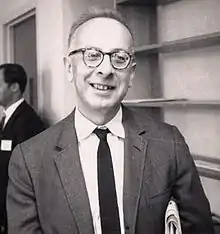Max Black
Max Black (24 February 1909 – 27 August 1988) was a British-American philosopher, who was a leading figure in analytic philosophy in the years after World War II. He made contributions to the philosophy of language, the philosophy of mathematics and science, and the philosophy of art, also publishing studies of the work of philosophers such as Frege. His translation (with Peter Geach) of Frege's published philosophical writing is a classic text.
Max Black | |
|---|---|
 | |
| Born | February 24, 1909 |
| Died | August 27, 1988 (aged 79) |
| Nationality | British American |
| Alma mater | Queens' College, Cambridge |
Notable work | The Identity of Indiscernibles |
| Era | 20th-century philosophy |
| Region | Western philosophy |
| School | Analytic philosophy |
| Institutions | Institute of Education University of Illinois Cornell University |
Main interests | Philosophy of language Philosophy of mathematics Philosophy of science Philosophy of art |
Notable ideas | Criticism of Leibniz' law |
Influenced
| |
Life and career
Born in Baku, present-day Azerbaijan, of Jewish descent,[2] Black grew up in London, where his family had moved in 1912. He studied mathematics at Queens' College, Cambridge where he developed an interest in the philosophy of mathematics. Russell, Wittgenstein, G. E. Moore, and Ramsey were all at Cambridge at that time, and their influence on Black may have been considerable. He graduated in 1930 and was awarded a fellowship to study at Göttingen for a year.
From 1931–36, he was mathematics master at the Royal Grammar School, Newcastle.
His first book was The Nature of Mathematics (1933), an exposition of Principia Mathematica and of current developments in the philosophy of mathematics.
Black had made notable contributions to the metaphysics of identity. In his "The Identity of Indiscernibles", Black presents an objection to Leibniz' Law by means of a hypothetical scenario in which he conceives two distinct spheres having exactly the same properties, thereby contradicting Leibniz' second principle in his formulation of "The Identity of Indiscernibles". By virtue of there being two objects, albeit with identical properties, the existence of two objects, even in a void, denies their identicality.
He lectured in mathematics at the Institute of Education in London from 1936 to 1940. In 1940 he moved to the United States and joined the Philosophy Department at the University of Illinois at Urbana–Champaign. In 1946 he accepted a professorship in philosophy at Cornell University. In 1948, he became a naturalized citizen of the United States. Black advised the philosophy dissertation of American novelist William H. Gass. He was elected a Fellow of the American Academy of Arts and Sciences in 1963.[3] Black died in Ithaca, New York age 79. His younger brother was the architect Sir Misha Black.
Selected bibliography
- Black, Max (1937). "Vagueness: An exercise in logical analysis". Philosophy of Science 4: 427–455. Reprinted in R. Keefe, P. Smith (eds.): Vagueness: A Reader, MIT Press 1997, ISBN 978-0-262-61145-9
- Black, Max (1938). "The Evolution of Positivism" Modern Quarterly, vol. 1. No. 1.
- Black, Max (1949). Language and philosophy: Studies in method, Ithaca: Cornell University Press.
- Black, Max (1950). The Nature of Mathematics and the Mathematics of Nature, The Humanities Press.
- Black, Max (1954). "Metaphor," Proceedings of the Aristotelian Society, 55, pp. 273–294.
- Black, Max (1959). "Linguistic relativity: The views of benjamin lee whorf," The Philosophical Review. Vol68, No2, (April 1959). pp228–2238.
- Black, Max (1962). Models and metaphors: Studies in language and philosophy, Ithaca: Cornell University Press.
- Black, Max (1979). "More about Metaphor," in A. Ortony (ed): Metaphor & Thought.
References
- "Emily Elizabeth Constance Jones (Stanford Encyclopedia of Philosophy)". Plato.stanford.edu. Retrieved 2016-04-28.
- Encyclopaedia Judaica, 2nd ed.
- "Book of Members, 1780–2010: Chapter B" (PDF). American Academy of Arts and Sciences. Retrieved July 26, 2011.
External links
- O'Connor, J.J. and Robertson, E.F., "Max Black: Biography", School of Mathematics and Statistics, University of St Andrews, Scotland.
- Biography at the MacTutor History of Mathematics Archive
- Guide to the Max Black Papers, Cornell University Library
- The Prevalence of Humbug, The Prevalence of Humbug and Other Essays (Cornell University Press, 1983).
